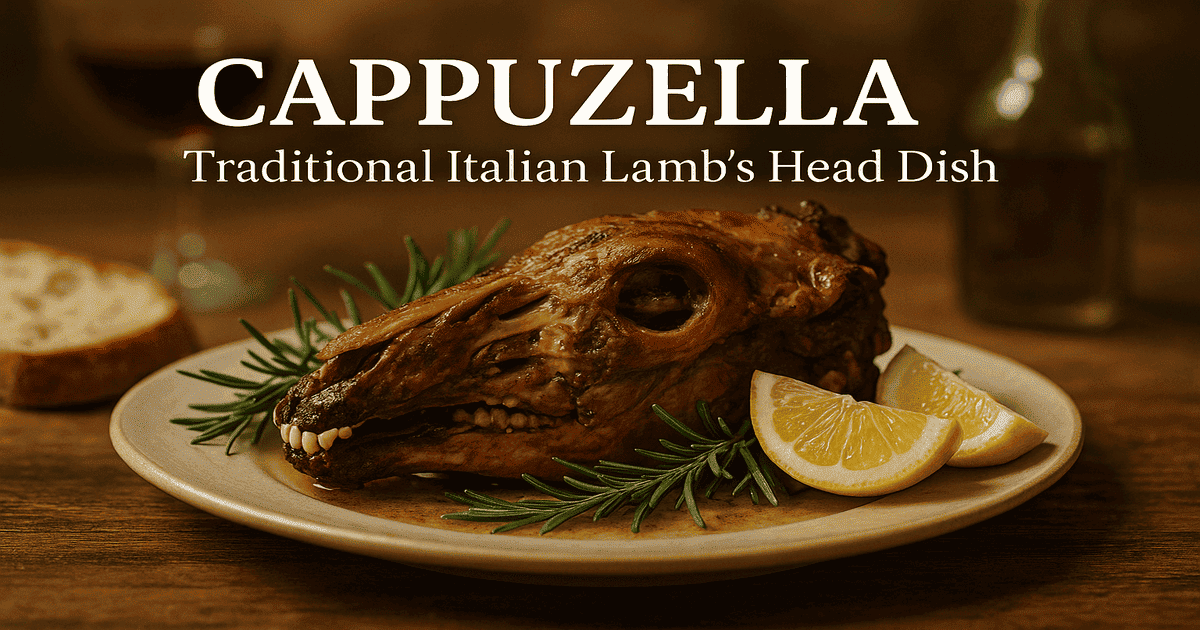Introduction
Every cuisine carries dishes that outsiders might find unusual, but for locals they represent heritage, resilience, and comfort. One such dish is cappuzella—a traditional Neapolitan preparation of lamb’s head. While it may surprise modern diners, cappuzella has deep cultural roots in southern Italy, particularly during Easter, when lamb is central to the table.
This guide explores cappuzella with respect and depth: its origins, how it’s prepared, its role in Italian culture, and how chefs reinterpret it today. By the end, you’ll understand why this dish matters—not just as food, but as a living connection to history and tradition.
What is Cappuzella?
The word cappuzella (also spelled capuzzelle) comes from the Neapolitan dialect and translates roughly to “little heads.” True to the name, the dish features a lamb’s head cooked whole, often split for easier serving.
Different parts of the head offer distinct flavors and textures:
- Cheeks – tender and richly flavored.
- Tongue – firm, meaty, and satisfying.
- Eyes – soft and gelatinous, considered a delicacy by many.
- Brain – creamy and delicate when cooked gently.
For those raised with it, cappuzella is less about novelty and more about respect for the animal and the land—a cornerstone of traditional southern Italian cooking.
Historical & Cultural Origins
Cappuzella comes from Naples and surrounding regions, where lamb has long symbolized renewal and sacrifice, especially at Easter. The dish is part of cucina povera—Italy’s “peasant cuisine”—which emphasizes using every part of an animal.
Historically:
- Families with limited resources wasted nothing; the lamb’s head was both practical and nourishing.
- Religious symbolism made lamb central to Easter meals, and cappuzella became part of that tradition.
- Italian immigrants carried the dish abroad, especially to New York and New Jersey, where it occasionally appeared in Italian-American kitchens and restaurants.
Cappuzella thus reflects both necessity and celebration—a duality common in the world’s most enduring dishes.
Traditional Preparation
Preparing cappuzella requires care, patience, and respect for the ingredient. The process traditionally includes:
- Cleaning – The lamb’s head is singed to remove hair, scrubbed, and split in half.
- Seasoning – Rubbed with olive oil, garlic, rosemary, parsley, salt, and pepper.
- Cooking – Slowly roasted in a wood-fired oven, braised in a pot with wine, or grilled over open flames.
- Serving – Presented at the table and shared, with diners savoring different parts according to preference.
What might seem unusual to newcomers is, for locals, a familiar act of gathering and honoring tradition.
Cappuzella Recipe: A Home-Cooked Version
For adventurous home cooks, cappuzella can be prepared with guidance from a good butcher. Here’s a simplified recipe.
Ingredients
- 1 lamb’s head, split and cleaned
- 3 cloves garlic, minced
- 2 tbsp olive oil
- 2 sprigs fresh rosemary
- 1 tbsp chopped parsley
- 1 tsp sea salt
- ½ tsp black pepper
- Juice of 1 lemon
- Optional: ½ cup dry white wine for braising
Instructions
- Preheat oven to 180°C (350°F).
- Combine olive oil, garlic, herbs, salt, pepper, and lemon juice. Rub over the head.
- Place in a roasting pan. For braising, add white wine and cover.
- Roast 90 minutes, basting occasionally, until meat is tender.
- Serve hot, with roasted potatoes or crusty bread.
Tip: If a whole head feels daunting, start with lamb cheeks or tongue, which are easier to source but capture the same flavor profile.
Modern Interpretations
While traditionalists maintain the old methods, modern chefs have reimagined cappuzella for today’s diners:
- Deconstructed presentations – Using cheeks or tongue in refined dishes.
- Fusion twists – Incorporating flavors from North Africa or the Middle East.
- Fine dining – Serving cappuzella-inspired plates in a way that emphasizes flavor without confronting diners with the full head.
These approaches balance respect for heritage with the realities of contemporary dining preferences.
Nutritional Value
Beyond tradition, cappuzella is nutritionally rich:
- Protein from cheeks and tongue.
- Iron and B vitamins vital for energy and red blood cell production.
- Omega-3s from brain and eyes.
Like all organ meats, it should be enjoyed in moderation due to cholesterol content, but it remains a nutrient-dense option compared to more processed meats.
Cappuzella in Media & Pop Culture
Cappuzella occasionally appears on social media, sometimes framed as a curiosity. On platforms like Reddit, photos spark debates about food culture, sustainability, and shock value.
While outsiders may see it as extreme, those familiar with nose-to-tail cooking view it as part of a broader conversation: respecting animals, reducing waste, and preserving heritage.
Where to Experience Cappuzella
If you want to try cappuzella yourself:
- Italy – Look to Naples and surrounding towns during Easter.
- Italian-American enclaves – Some restaurants in New York and New Jersey occasionally feature it.
- Food festivals – Heritage events sometimes include cappuzella as part of cultural demonstrations.
Asking locals or exploring traditional trattorias increases your chance of finding it authentically prepared.
Ethical & Cultural Perspectives
Serving an entire head can feel unsettling for some diners. Yet advocates argue cappuzella reflects one of the most sustainable food philosophies: use the whole animal. This “nose-to-tail” approach contrasts with modern industrial systems that discard edible parts.
For Italians, cappuzella is not sensational but symbolic—a dish rooted in respect, necessity, and continuity.
Conclusion
Cappuzella is more than a lamb’s head on a plate. It’s a reflection of Neapolitan culture, culinary resilience, and sustainable tradition. For centuries, families have gathered around it during Easter and other celebrations, sharing not just a meal but a heritage.
In today’s culinary world, cappuzella challenges us to look beyond appearances, appreciate nose-to-tail cooking, and value traditions that honor both food and community. Whether you try it at home, seek it in Italy, or simply learn about its story, cappuzella offers an important lesson: the dishes that surprise us most often have the richest histories to tell.
Also read: RotMG DPS Calculator Guide (2025)




